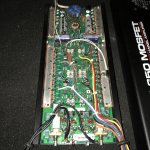Have my first cmax 45ah bank and I have a power 650 mosfet 1992 rev. Is it capable of handling 15.2 volts with the battery charging that high? I was reading through the Power 300 manual and it says “
The Rockford Power 300 is an automotive stereo power amplifier which
will provide state-of-the-art sound in cars, vans, boats, or wherever a 9
to 16 Volt battery is available.” And if it can would it be recommended to be recapped/ gone through? Would be using it alongside a taramps bass 8k for a little loud daily. Or is 14.4 the highest?
The Rockford Power 300 is an automotive stereo power amplifier which
will provide state-of-the-art sound in cars, vans, boats, or wherever a 9
to 16 Volt battery is available.” And if it can would it be recommended to be recapped/ gone through? Would be using it alongside a taramps bass 8k for a little loud daily. Or is 14.4 the highest?
So would rail voltage increase with a higher input voltage?The 300 is a newer design with over-voltage protection and regulation for the rails. The 650 has a much different power supply. I don't see regulation that would protect the output stage of the 650 from over-voltage.
Attachments
In the 650, I think it would. You can confirm by connecting it to a variable 12v supply and increasing the voltage while monitoring the rail voltage. The diagram gives ±45v as rails. The outputs are only good for another ±5v.
Bummer guess it’s not meant for those extreme applications. Was going use it to power six prv midrange speakers. And it’s my favorite amplifier
No was going to have it charge at 15.2 around there no higher. Do you know if the 800a2 would shut off at that voltage? Would also make a nice mids amp as well
The 800a2 uses the same voltage divider for the over-voltage protection as the 300. As soon as the voltage across the 316 ohm resistor is pulled above the 5v reference (at about 15.9v on the remote turn-on terminal) the amp will shut down.
The 800a2 will very likely need a fan.
The 800a2 will very likely need a fan.
Attachments
Just thinking aloud: if supply transformer winding wire is exposed (or under a single sheet of Mylar, nothing fancy), maybe you can unwind one secondary turn, even two.
That should add enough safety downwards.
MOS 650 transformer is shown as a "mystery box" but "300" one shows primary 6 turns of #14 wire, secondary 15 turns of #16 , "650"one could be very similar.
Maybe over voltage sensor should also be tweaked, but the main danger, power transistor voltage limit would be avoided, at a hardware level, not just counting on a voltage regulator turning switcher OFF before a danger level is reached.
In my book, a safer approach.
I suggest you "map" Mos650 transformer, find secondary, and check whether you can pull a couple turns where needed.
Post your findings here.
That should add enough safety downwards.
MOS 650 transformer is shown as a "mystery box" but "300" one shows primary 6 turns of #14 wire, secondary 15 turns of #16 , "650"one could be very similar.
Maybe over voltage sensor should also be tweaked, but the main danger, power transistor voltage limit would be avoided, at a hardware level, not just counting on a voltage regulator turning switcher OFF before a danger level is reached.
In my book, a safer approach.
I suggest you "map" Mos650 transformer, find secondary, and check whether you can pull a couple turns where needed.
Post your findings here.
Last edited:
All of the 650s that have come across my bench have epoxy on at least the upper half of the transformer. It wouldn't be easy to map it out or partially unwind it without being somewhat destructive.
- Home
- General Interest
- Car Audio
- Are older amplifiers capable of 15 volts?
